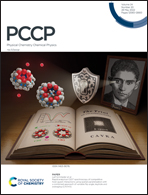Electronic structure and magnetic coupling in selenium substituted pyridine-bridged bisdithiazolyl multifunctional molecular materials†
Abstract
Bisdithiazolyl radicals have furnished in recent years multiple examples of molecular materials with promising conductive and magnetic properties. The electronic band structure and magnetic ordering in four different isostructural pyridine-bridged bisdithiazolyl and Selenium substituted compounds have been studied by means of hybrid DFT based methods as implemented in the CRYSTAL code. The full rationalization of the properties of these multifunctional magnetic molecular materials requires a careful description of their complex open-shell electronic structure. The results describe the systems as narrow band (0.2–0.3 eV dispersion) open-shell semiconductors with a gap of 1.15–1.40 eV between the valence and conducting bands. The bands defining the insulating gap are dominated by orbital contributions arising from the heteroatoms sitting in the outer rings. A low energy closed-shell metallic solution is found at 0.25–0.35 eV above the magnetic solutions thus suggesting a complex mechanism for electric conduction with band and hopping contributions. The observed trend of the conductivity is in line with the variation of the insulating gap but more rigorous modelling is required to take into account the details of the band structure of the systems. For all the systems the spin density is well localised on the molecular units and is independent of the magnetic solution. Thus the system can be described as an ensemble of well-defined S = 1/2 magnetic centres using a two-body Heisenberg–Dirac–van Vleck spin Hamiltonian. The lowest energy electronic solutions are in line with the observed magnetic behaviour at low temperature. The set of competing magnetic exchange interactions that emerges from using a suitable mapping to consistently describe the low energy magnetic solutions explains the variety of magnetic responses (absence of long-range magnetic order, antiferromagnetism or ferromagnetism) of the four studied compounds at low temperatures.

- This article is part of the themed collection: 2022 PCCP HOT Articles


 Please wait while we load your content...
Please wait while we load your content...